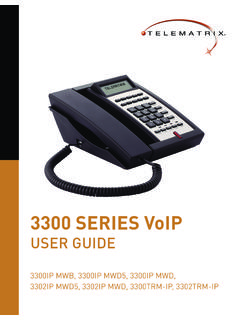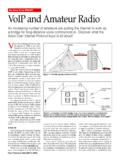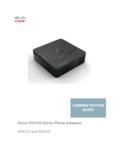Transcription of DACT and VoIP White Paper - Keltron Corp
1 15:36:09 15:36:09 15:36:09. T10/28/10. e c h n o l 10/28/10. o g y W h 10/28/10. ite Paper 15:36:09 15:36:09 15:36:09. 02/05/15 02/05/15 02/05/15. 20:36:09 20:36:09 20:36:09. The Effects of Digital Technology on Telephone Line Signals For Alarm Monitoring: DACTs and voip . Overview In 1983, digital alarm communicator transmitters (DACTs). were introduced into the fire alarm codes as a viable fire alarm signaling technology for monitoring fire alarms. Once the mainstay of the alarm monitoring industry, changes in technology are contributing to their pending obsolescence as other technologies are gaining in economics, reliability and availability. Unintended consequences The first decade of the new millennium saw the proliferation of Ethernet-based technologies and digital electronic infrastructure expansion.
2 By 2010, organizations and companies with multi-building facilities migrated from standard telephone infrastructure to Voice-over Internet Protocol ( voip ). Entities with alarm systems using DACTs for signaling experienced unintended consequences from this migration in that the DACTs were rendered unable to consistently and reliably transmit fire and security alarms to the receiving station or monitoring system. Although this issue does not directly affect testing entity listings (UL, ULC, ETL, etc.), it does present National Fire Protection Agency (NFPA) code compliance conflicts and technical incompatibility. Technical explanation Many alarm systems are designed to transmit alarm signals as a series of beeps and tones over analog telephone lines, therefore DACTs may not function properly in a voip environment.
3 The Internet is designed to optimize data transmission. It is a "packet" switched, digital network in contrast to the PSTN. which is a "circuit" switched, analog network, that is designed to optimize voice transmission. To optimize voice transmission (which include tones that DACTs transmit), voip technologies must convert analog tones into bits of data to transmit them over the network, and convert them back to analog that can be understood by the receiver. This conversion can create distortions and delays, causing unintelligible reception at the central monitoring receiver. Although the human ear is more tolerant of slight distortions in voip communications, digital alarm receivers require precise communication. The analog signals transmitted by the DACT may not be recreated properly within enough time or frequency for the digital alarm communicator receiver (DACR) to decode them after the signals are converted to digital and back again by the voip system.
4 The voip system is designed for transmitting data traffic and not for analog voice type data (tones) and was not designed to be DACT-compatible. Ancillary issues There are a range of other issues when connecting DACTs using a voip system. Because of technology changes and the emergence of newer, more accurate and reliable technologies, DACTs are being written out of the NFPA code with every new NPFA update cycle that requires more stringent requirements. NFPA Code: the following excerpt means that as of 2013, a DACT using two telephone lines is no longer compliant with the National Fire Protection Agency Alarm Code: "NFPA 72 - 2013 Transmission Channels (A) A system employing a DACT shall employ one telephone line (number). In addition, one of the following transmission means shall be employed: (1) One way private radio alarm system (2) Two-Way RF Multiplex system (3) Transmission means complying with " (ref: Performance-Based Technologies).
5 DACTs and voip . 15:36:09 15:36:09 15:36:09. 10/28/10 10/28/10 10/28/10 w w w. k e l t r o n c o r p . c o m 15:36:09 15:36:09 15:36:09. 02/05/15 02/05/15 02/05/15. 20:36:09 20:36:09 20:36:09. Ancillary issues continued Installer disclaimers: the connection of DACTs to voip does not always provide a suitable path for transmitting alarm signals from an owner's premises to the central station receiver. The following is a commonly used example of a disclaimer from a fire alarm system installer: "Although the following provides information about connecting alarm communicators to voip , please be aware that many voip suppliers distinctly specify in their literature and web pages that alarm systems are not to be connected to their telephone interfacing devices.
6 Many alarm equipment vendors also do not recommend the connection of their products to voip . I specifically do not recommend such installations. Alarm companies that connect communicators to voip do so at their own risk.". Proper installation and testing: the electronics connection of the DACT to the voip adapter can create communications problems. Installing and testing the DACT so as to take priority over other telephones is necessary to ensure alarm signal transmission and enable remote downloads for FACP programming. If the alarm device cannot communicate with the monitoring station receiver, it is possible that the particular voip service uses a compression technology that cannot accurately reproduce the sounds from the alarm communicator over the Internet.
7 It is also essential to program the DACT to send regular test messages to the monitoring station receiver. Alarm communicators connected to voip adapters can exhibit inconsistencies in communicating with the receiver and may require multiple attempts for FACP signals to reach the monitoring station over voip . Any change to the voip service, ISP adapter, or network equipment at the monitored location may disable alarm communication over the voip connection. The test messages ensure functional digital communication and provide notification if there is a problem. Backup power: voip adapters and cable modems are not generally connected to a backup power supply. While telephone lines are powered from the telephone company's central office and are fairly reliable during power outages, there is no universal power backup for cable modems, DSL.
8 Adapters, or voip adapters. It is essential to connect an uninterruptible power supply (UPS) to provide backup power to all devices within the alarm system. False phone line problem alerts: DACTs that provide telephone line sensing can create issues with voip technology. voip adapters may or may not provide the type of electrical signal that the alarm panel perceives as viable. It is possible that the alarm panel may indicate a telephone line trouble when the voip telephone system is functional. Recommendations Keltron strongly recommends that companies and organizations using DACT with voip fire alarm signaling consider migrating to a new signaling technology which is voip -compatible or wireless. Keltron offers both Ethernet signaling and mesh wireless systems, and solutions that leverage the building owner's existing investment in alarm panels and alarm transmission and receiving equipment.
9 Keltron develops and manufactures universally-compatible, UL listed life safety event management systems for multi-building facilities and municipal environments. Solutions include Ethernet (IP), active network radio, distributed multiplex, digital communicator/receivers, and direct wire systems. For more information visit or contact us at 781-894-8710. 2015 Keltron Corporation. All rights reserved. Keltron Corporation 101A First Avenue, Waltham, MA 02453 voice fax






